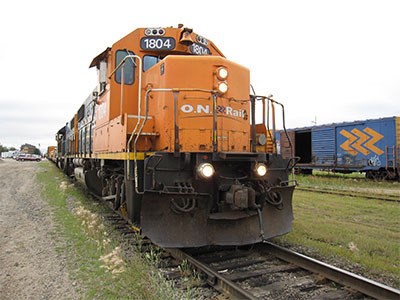The Mushkegowuk Council’s conceptual plan for a Ring of Fire railway, power corridor and James Bay port took a strange twist with talk of a possible partnership talk a private railway company with a keen eye on buying the Ontario Northland Railway.
Mushkegowuk Grand Chief Lawrence Martin caused a media stir in late January at an energy conference in Timmins when he told reporters that his northeastern Ontario tribal council was considering teaming up with TGR Rail to extend rail service to the coast and into the Ring of Fire.
TGR, a Toronto-based rail services company, claimed it had the financing and the team in place to acquire and expand the rail assets of the North Bay-based Ontario Northland Transportation Commission (ONTC).
The company contacted Mushkegowuk last year when the tribal council on the eastern side of the Ring of Fire began floating the idea of an energy infrastructure corridor.
It calls for a multi-use easement corridor of power, fibre optic and rail links that would provide all-season access and grid-based electricity, supplied by Hydro Quebec, to isolated communities and the mineral deposits with a connection to a proposed saltwater port to move chromite ore to the coast.
But in an oddly written news release, TGR proclaimed it had already reached a “landmark breakthrough” for the Ring of Fire with a proposal on the table to begin negotiations with Mushkegowuk on a potential partnership to finance, build and operate a 410-kilometre railway.
The release contained quotes pulled from a Timmins media report in which Martin spoke of TGR’s queries on leasing land from the council and a promise to give Mushkegowuk an ownership stake in the railway.
TGR chairman Ron Dancey was quoted as saying his company had the capital to upgrade the Ontario Northland and promised competitive freight rates for the mining companies.
The company’s pronouncement was quickly dismissed by Northern Development and Mines Minister Michael Gravelle and Ontario Northland management who stated the Ontario Northland isn’t for sale and “will remain in public hands.”
Dancey was unavailable for comment. TGR president Kevin Street was vague in discussing his company’s capabilities, clients, financial backers, and whether they had the expertise to take on a project of this scale.
“There are a number of financiers involved,” he said. “We do a little bit of everything. There’s a great deal that goes into railway operations from the training to paperwork to maintenance (and) there’s financing. We have a team of great expertise in the industry and we’re privileged to have them.”
The company website presents itself as providing contract track maintenance, switching, safety training, engineering and construction.
Street dodged a question on its purchase plans for the Ontario Northland, saying that could be best answered by the Mushkegowuk chiefs.
This is the second time TGR has taken a stab at acquiring the railway.
In 2012, the company proclaimed it was a bidder during the McGuinty government’s aborted attempt to divest itself of the Crown agency.
After meeting with Mushkegowuk chiefs, Grand Chief Martin said he has received permission to proceed with talks with TGR, the province, and any other parties entering their traditional territory, which includes the Ring of Fire.
“From the beginning it seemed like Mushkegowuk was not part of the (Ring of Fire) discussions and so we had to put something on the table as another option.”
Suzanne Leclair, Mushkegowuk’s business advisor, cautioned that no partnership currently exists with TGR, though signing the MOU would initiate a due diligence phase.
“TGR seems to be confident they have the financial backers,” she said. “They did mention verbally who their bankers were and that’s why we decided that we’re going to look a little deeper. We were favourably impressed, but that’s verbal, and being a lawyer, I’d like to see that in writing.”
Mushkegowuk has the ability to construct transmission corridors through its ownership of Five Nations Energy, but is seeking expertise and financing in other areas for partnership possibilities.
Leclair characterizes the concept as a First Nation-led “policy option” that might break the federal and provincial impasse on building Northern infrastructure.
She was careful to distance Mushkegowuk from any involvement on an ONR acquisition plan, explaining the corridor would be available to any rail operator able to partner with First Nations.
An Ottawa political news website reported that the Mushkegowuk-TGR proposal had attracted interest from the Prime Minister’s Office, but Chris McCluskey, spokesman for federal Natural Resources Minister Greg Rickford, the government’s Ring of Fire point man, said any government dialogue with Mushkegowuk has been limited to talks with FedNor.
“Contrary to media reports, our government has not expressed a view on any such proposal.” Further, any sale of the ONR falls under provincial jurisdiction, he said.
Leclair said Mushkegowuk has not fully consulted with the Ontario government or the Matawa First Nations, the tribal council on the west side of the Ring of Fire.
Mushkegowuk met with them twice last year to informally discuss the corridor.
Martin said a meeting between Mushkegowuk and Matawa chiefs was planned for Timmins in late February.
The Ring of Fire mining companies have tabled access routes to their deposits coming from the south and west, and Leclair views their eastern routing as being complementary to the Ring of Fire development process, providing Matawa agrees to it.




